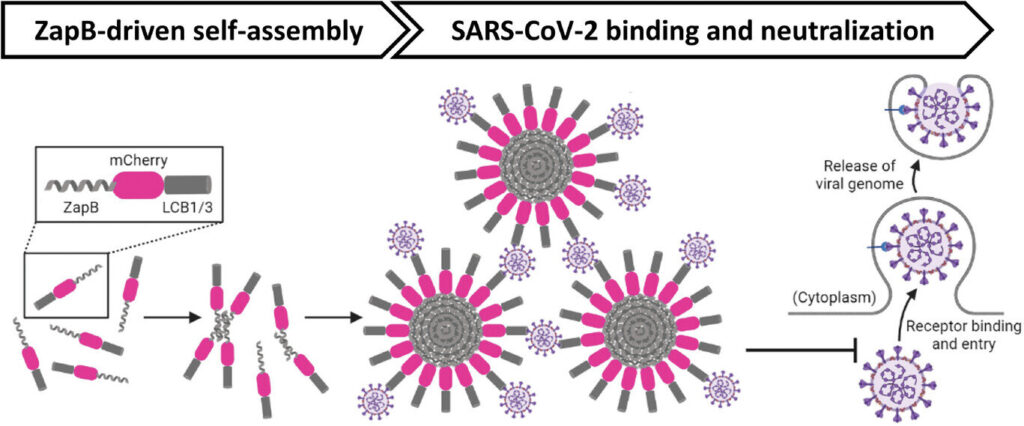Researchers from the IBB-UAB have developed a new class of nanostructures capable of trapping and neutralizing large quantities of the SARS-CoV-2 virus particles, both in liquid solutions and on the surface of materials.
These novel nanoparticles could be used to manufacture antiviral materials such as wastewater and air filters, and could be exploited to develop new tests for the early detection of COVID-19. Moreover, the nanoparticles could be redesigned to target other pathogens.
The study was led by researchers from the Institute for Biotechnology and Biomedicine of the Universitat Autònoma de Barcelona (IBB-UAB), who highlight the potential of the developed nanostructures for the manufacturing of new antiviral materials. The study was published in the journal Advanced Healthcare Materials.
The new nanoparticles, called LCB1-NPs and LCB3-NPs, are formed by repeats of three proteins, which are joined together thanks to the self-assembly properties of one of the three, called ZapB.
In the genetic engineering strategy that was implemented, the researchers fused ZapB with the mCherry protein, which confers red fluorescence to the nanoparticles, and to this union they added the LCB1 and LCB3 proteins, which provide the ability to bind and neutralize the SARS-CoV-2 virus. Thus, by forming these nanostructures, it was possible to localize all these functions in a single nanoparticle.
The researchers underscore the high affinity of the nanoparticles to bind to the viral spike protein that allows SARS-CoV-2 internalization into cells. This process enables the nanoparticles to neutralize the infection in both liquid solutions and be immobilized on a surface. This demonstrates the great versatility of this new antiviral nanomaterial, paving the way for its utilization in a multitude of applications.
“Each nanoparticle is composed of many LCB1 or LCB3 proteins, resulting in a high density of SARS-CoV-2 binding sites that allow each nanoparticle to bind to more than one virus. This greatly increases their potential as an antiviral material compared to other materials in which each nanostructure can only bind to one single particle of the virus,” explains IBB-UAB researcher Marc Fornt, first author of the study.
The red fluorescence makes it easier to track and localize the nanoparticles with the naked eye, which makes them much easier to handle.
An experiment using the nanoparticles to engineer a virus filter has allowed the researchers to demonstrate the ability of this new nanomaterial to trap and neutralize large quantities of SARS-CoV-2.
Among its applications are the filtering of wastewater containing secretions from patients affected by COVID-19 to prevent them from reaching the water system, and the filtering of air in sensitive areas such as hospital wards.
The nanoparticles could also be used in the manufacturing of new ultra-sensitive detection tests to diagnose the disease in the early stages of infection, when the viral load is still very low.
“These new nanoparticles are also of great interest for the industrial production of antiviral materials due to the simplicity, speed and low cost involved in making them,” says IBB-UAB researcher and director of I3PT Salvador Ventura, who coordinated the study.
The modular system through which the nanostructures were generated allows the protein that recognizes and neutralizes SARS-CoV-2 to be replaced by proteins that recognize other pathogens of interest.
“This flexibility provides a solid framework for the generation of new materials to combat potential emerging infectious diseases effectively and rapidly, particularly if combined with recent advances in de novo protein design,” concludes Salvador Ventura.


